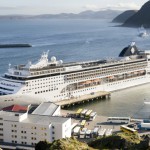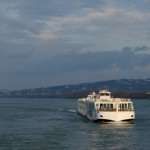A mere 12 months ago, you could describe the entire river cruise industry as being “hot” and getting hotter. After all, more new vessels were coming on-line than at any other point in history, and that explosive increase in capacity was largely fueled by increased demand from guests.
This year though, river cruising isn’t merely “hot” anymore; it’s explosive, and as the latest trends show, it isn’t always about the ship this year – though new vessels still play an important role in the river cruise industry.
The Ships Are Getting Better

When Viking River Cruises broke a Guinness World Record this past March in Amsterdam by christening ten new river cruise vessels on a single day, the company also unveiled a small but subtle stream of changes to its Viking Longships, the first pair of which had set sail only a year earlier. Included aboard the new generation of Viking Longships were redesigned atriums with a greater focus on woods and soft tones rather than the colder, yet elegant, marble-and-glass concept aboard the line’s original Longships.
Part of the rationale behind these subtle changes: As Viking rapidly retires its original fleet and transitions to an all-Longship fleet, the company is having to keep up with the competition while at the same time resisting the urge to “cookie-cutter” its ships.
Uniworld Boutique River Cruises is poised to deliver the first sister-ship to its highly successful S.S. Antoinettenext year, and the company has just completed a massive refurbishment program of its existing fleet in conjunction with Red Carnation Hotels, a sister company.
Avalon Waterways continues to draw from the innovative Avalon Panorama for its newbuilds, and has drawn accolades from guests for innovative stateroom layouts that feature beds positioned so that they face the French Balcony windows and not a mirror or wall as on many other river cruise vessels.
AmaWaterways won accolades with its AmaCerto, which features textures and stylings that you’d normally see in a boutique luxury hotel or on a larger cruise ship, including a glass-enclosed elevator that traverses the passenger decks and acts as a focal point for the ship’s reception area and central staircase, creating – in effect – a “mini atrium.”
Growth In Portugal & the Douro Valley

To see how rapidly river cruises on the Douro River have grown, consider this: Both AmaWaterways and Uniworld took delivery of new vessels this year, both of which were christened on the same day and by super stars of the stage and screen. Next year, Viking River Cruises is getting into the game, launching scaled-down versions of the Viking Longships along the Douro.
Part of the Douro River Valley’s appeal can be found in its history: Porto has been the epicenter of Port wine production for centuries and is experiencing something of a modern-day renaissance thanks to the renewed focus on culinary and wine-themed cruises.
The Douro River is like the Caribbean was in the 1960s: relatively untouched. Our advice: Cruise now before the crowds descend on the region in the next few years.
More Theme Cruises

Theme river cruises aren’t exactly new, but the latest crop of voyages revolving around various special interests are. Gone are the days when “Theme Cruise” meant sailings that focused solely on wine; instead, no matter what your interest, there probably is a theme cruise that will appeal to you.
AmaWaterways has themed voyages on nearly 30 departure dates this year and is poised to roll out more next year. In addition to the company’s popular “In Celebration of Wine” voyages and “Jewish Heritage” journeys, the line is also pioneering some unique themes, like the first “knitting cruise” and even a special Gluten-free cruise where all the cuisine served onboard will be prepared for those who are sensitive to gluten.
Avalon Waterways is also getting into the theme cruise arena, with some stunning World War I and II history cruises lined up for next year as many parts of Europe prepare to mark the centenary of the start of WWI and the 70th anniversary of the D-Day Landings at Normandy.
The Emergence of Asia
While Asia still exists as one of the less-explored river cruise destinations, it’s poised to have the same kind of growth that European river cruising has had over the past decade, with a bevy of new ships, itineraries and operators launching in the area in recent months.
These voyages tend to be paired with much longer overland journeys to create trips that can be, in some cases, as much as three weeks in length.
Without limitations on the dimensions of ships plying China’s Yangtze, some of the new vessels in this region – like Century Legend and Century Paragon – can be as elaborate as the newest cruise ships plying the oceans of the world, with multi-story atriums, indoor spas and swimming pools, and accommodations that routinely exceed 200 square feet.
Along the Mekong, the focus is on more intimate and traditionally styled vessels, some of which carry as few as 20 guests at a time.
The real draw of both destinations, though, can be found in the opportunity to visit villages, towns, and monuments that would be difficult to see otherwise. Many river cruise operators in the area, like Pandaw, place great emphasis on local culture, from culinary offerings to traditional ceremonies. AmaWaterways even sponsors a local school in Cambodia, and guests have the opportunity to visit and interact with the children.
There’s one last trend that has become apparent in the river cruise industry in the past year, and that is Change. The industry is changing and evolving at a rapid rate as more and more travellers discover the convenience and the cost-effective nature of river cruising.
That change is poised to continue well on into the future as each river cruise line looks toward the next “big thing” in river cruising.



